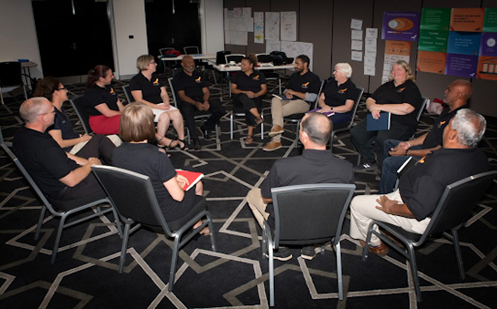Cultural safety
'Workplace cultural safety supports Indigenous staff to feel welcome and included, providing them a sense of belonging. When a safe Third Cultural Space is created, Indigenous staff feel respected and are comfortable to put forward their ideas, contribute knowledges and identify ways they can work between the school and the Indigenous community.’ (Simone, 2022)
Cultural safety has been defined as ‘being able to practise your culture free of ridicule or condemnation’ (Brown et al., 2020, p. 11).
Cultural safety relates to First Nations Australian students and staff. For staff, cultural safety ‘occurs when a workplace acknowledges, respects and accommodates difference’ (Brown et al., 2020, p. 11).

Research has found the following:
In a survey to more than 1,000 First Nations workers across Australia, the Gari-Yala Report found that 28% felt their workplaces were culturally unsafe. The workers responded that:
- they did not feel safe and supported in their working environment
- their skills, perspectives and experiences were not valued.
Culturally safe spaces enable ways of working where knowledges can be shared both ways. Matthews (2008) states ‘activity should work both ways and emphasise sharing of knowledge from one culture to the other’ (p. 3). First Nations Australians share knowledges of real, meaningful and authentic cultural contexts for mathematics and teachers share curriculum content knowledge of mathematics.
Culturally safe spaces are created when non-Indigenous people enact processes to work ‘with’ First Nations Australians as opposed to working ‘to’ or ‘for’ them (Singh & Major, 2017; Stavrou & Murphy, 2019).
Workers in identified positions1 in schools should know that their voices and perspectives are welcomed and valued across the whole-school environment. Identified positions help people who experience disadvantage to access equal opportunity in employment. Identified positions also benefit employers by allowing them to hire a person with particular experiences and expertise, such as cultural knowledge.
Teachers and school leadership are required to provide culturally safe spaces where First Nations Australians are enabled to discuss, practise and share their cultures and beliefs. Under the Australian Standards for Principals2, all principals have the responsibility to work with members of the school community to ensure a knowledge and understanding of the traditional rights, beliefs and culture of Australia’s First Peoples.
Implementation strategies and considerations
|
Strategy |
Rationale |
|
Consult Indigenous teaching assistants (if the school employs them) and Indigenous families about the cultural safety within the whole school environment |
|
|
Enable First Nations Australians to share their perspectives in identifying processes, policies and environments that are culturally unsafe |
|
|
Create culturally safe spaces where innovation and creativity are captured |
|
|
Acknowledge that cultural safety can be seen, felt and heard |
|
|
When working within the Third Cultural Space, enact High-Expectations Relationships |
|
1 Identified positions help people who experience disadvantage to access equal opportunity in employment. Identified positions also benefit employers by allowing them to hire a person with particular experiences and expertise, such as cultural knowledge (https://humanrights.gov.au/quick-guide/12047).
2 https://www.aitsl.edu.au/tools-resources/resource/australian-professional-standard-for-principals
© 2023 Commonwealth of Australia. These resources may be used under a Creative Commons Attribution-Non Commercial-No Derivatives (CC BY-NC-ND 4.0) licence. These resources were created by Stronger Smarter Institute and Indigenous knowledge-holders.